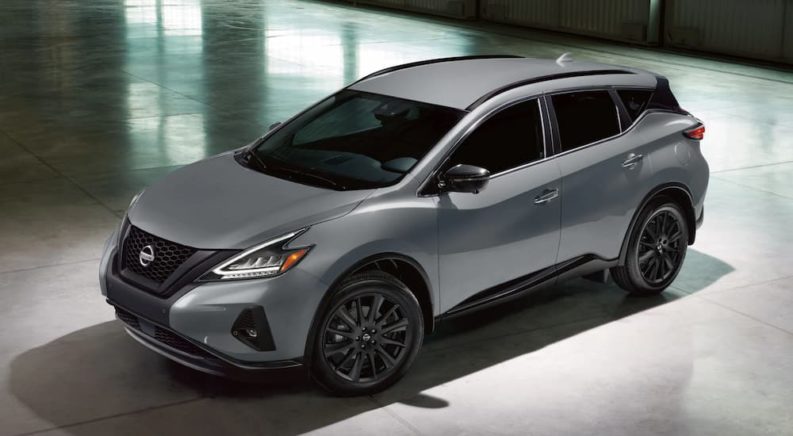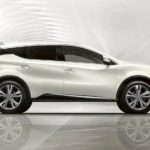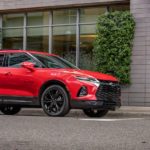If you see a Nissan Murano for sale at a car dealership, you might think that the sleek, modern crossover is a new entry in Nissan’s Canadian lineup. In fact, the model turns twenty years old in 2022, having first debuted at the 2002 New York International Auto Show. Of course, there have been plenty of changes made since then, but many of the features that separated the first Murano from the competition have stood the test of time. Let’s take a look at the Nissan Murano through the years and see what has changed with each new generation and what the vehicle has to offer Canadian drivers today.
First Generation: 2003-2007
In the early 2000s, the auto market was swimming with SUVs, making it a difficult field to stand out in. But the 2003 Murano incorporated stylistic and mechanical features that put it in a league of its own. For one thing, rather than try to cram as many passengers as possible into the cabin, the Murano debuted with two rows of seating, not three. This allows adults to sit comfortably in the back row, with reclining backrests and plenty of legroom. On the outside, the Murano’s sleek shape and rounded edges presented a more refined alternative to the boxy, utilitarian appearance of most SUVs. That style is matched on the interior, which has aesthetic touches like real aluminum trim alongside practical considerations like an abundance of storage.
Under the hood, all first-generation Muranos have a 3.5L V6 engine, which provides plenty of power while not being as thirsty for fuel as a V8. With 245 hp and a towing capacity of 1,587 kg, this is a full-fledged SUV. Nissan was an early adopter of Continuously Variable Transmission (CVT), a now-popular system that strikes a balance between power and fuel economy. The Murano’s top-notch performance and responsive handling won over not just practical car buyers but enthusiasts as well.
Second Generation: 2009-2014
Nissan skipped the Murano’s 2008 model year and kicked off the second generation with the 2009 model. This updated version was named a Top Safety Pick by the Insurance Institute for Highway Safety (IIHS) thanks to its crashworthiness. The 2009 Murano is still powered by a 3.5L V6, but it’s a revised version that provides 20 hp more than the old engine.
The exterior was given a complete makeover, with new head and tail lights, revised front fascia, and dual chrome exhaust tips. The interior was also updated with a wide center console, a redesigned instrument panel, a cargo divider, and an available dual-panel moonroof. The 2009 Murano has plenty of tech upgrades, with features ranging from dual-zone automatic climate control and power-return rear seatbacks to push-button ignition. Keyless entry became a standard feature starting with the 2010 Murano. The second generation also saw the introduction of other useful features, including a power liftgate, Bluetooth connectivity, automatic headlights, and blind-spot warning.
Murano CrossCabriolet: 2011-2014
While it was only around for a few years and not officially sold in Canada, we’d be remiss if we didn’t mention the controversial convertible version of the Murano, the CrossCabriolet. It was touted as the world’s first and only all-wheel drive crossover convertible and features the same powertrain as the standard Murano with a pretty similar interior. The exterior, however, is a whole new beast, featuring two doors instead of four and, of course, a soft top that can fold down to let drivers feel the rush of the open road. The model was short-lived and met with mixed reviews, but it does exemplify Nissan’s willingness to experiment with bold new ideas instead of always playing it safe. While this strategy might not have panned out for the CrossCabriolet, the out-of-the-box styling of the Murano itself has certainly proved to have staying power.
Third Generation: 2015-Present
For the Murano’s third generation, Nissan worked to incorporate new technology into the design, making the crossover even more comfortable, convenient, and practical. The aerodynamics, weight, and drivetrain were all updated to improve fuel economy. Safety was also a top concern, which is reflected in the fact that the 2015 Murano was named a Top Safety Pick+ by IIHS, the nonprofit’s highest award.
Both the front and back row seats were updated with Nissan’s Zero Gravity technology, making them more supportive and comfortable. The Murano also offers remote start capability, allowing drivers to turn on the climate control a few minutes before entering the vehicle. This can come in handy on cold winter days in Canada.
In addition to comfort, tech also brings added convenience to the latest generation. The 2015 Murano comes standard with an 18 cm high-resolution touchscreen, which gets bumped up to 20 cm in higher trims. A larger screen makes it easier for the driver to read vital information at a glance without taking their eyes off the road for too long. The overall layout of the cabin’s buttons, screens, and other controls is intuitive rather than overwhelming and clearly designed with simplicity in mind. To make connecting a smartphone to the interface easy and seamless, Apple CarPlay became available for the 2017 Murano, and the 2018 model made both Apple CarPlay and Android Auto standard features.
2023: The Murano of Today
The 2023 Murano still runs on a 3.5-litre V6 engine with CVT, but thanks to improvements to the powertrain over the years, it’s now more efficient. While the first generation Murano had a fuel consumption rating of 12.1 L/100 km combined, the 2023 model is rated at 10.4 L/100 km combined and as low as 8.5 L/100 km on the highway. Inside, the cabin is more comfortable than ever, with heated and ventilated front seats, USB and USB-C ports to keep personal devices charged and connected, and an available driver memory system that adjusts your side mirrors, seat, and steering wheel to your preferred settings automatically.
As safety technology has advanced, more driver assistance features have become standard on the Murano. For the 2023 model, every trim level is equipped with Nissan’s Safety Shield 360. This suite includes useful features like Automatic Emergency Braking with Pedestrian Detection, Rear Cross Traffic Alert, Rear Automatic Braking, Blind Spot Warning, Intelligent Lane Intervention, and High Beam Assist.
The 2023 Murano offers 1,897 litres of cargo space and a motion-activated power liftgate that makes accessing that cargo space easy, even if your hands are full. In Canada, all trims come standard with Intelligent All-Wheel Drive, which automatically balances the extra traction of AWD with the efficiency of 2WD, switching between the two depending on road conditions. The Murano also features speed-sensitive power steering, which is firm when you’re driving at highway speeds but lightens up at lower speeds so that you can have control over the vehicle in any situation.
A Unique SUV
While the Nissan Murano is certainly a practical vehicle for transporting people and cargo, it doesn’t focus on utility at the expense of passenger comfort. Its interior gives everyone room to stretch out and get comfortable, lending itself to being more of an on-the-go social space than just a means of getting from Point A to Point B. Meanwhile, its exterior is a blend of aerodynamics and stylish sculpting. While various tech features and body styles have come and gone, the elements that make the Murano stand out among the overwhelmingly overpopulated market of crossover SUVs have stood the test of time. In a market of vehicles all trying to do the same thing, the Murano’s uniqueness is a coveted feature that has won over plenty of drivers over the years and will likely continue to do so for years to come.




